Captured: Portraiture and the Permanent Collection
3 May 2008 – 7 September 2008

Rebecca Belmore True Grit, A Souvenir, 1989
We think of portraits as capturing a likeness, but is that all they capture? Drawing on works from the MacKenzie’s permanent collection,Captured: Portraiture and the Permanent Collection will create a dialogue examining the concept of portraiture through a survey of historical and contemporary portraiture by over 60 artists. Together with related exhibitions (Allen Sapp, Dorothy Knowles, Kent Monkmanand Wally Dion) they will expand the concept of the portrait to include those of community, time, place, history, memory, concept and consciousness.
In the most literal sense Captured presents a landscape of faces. Rather than create a chronological narrative, I have chosen to display groupings of work which look at gender, race, status and representation to draw attention to the many narratives behind our perceptions of portraiture. Some portraits are rendered naturalistically, some symbolically – however, behind each “portrait” there are assumptions about how we perceive and represent another person or the self.
Who or what do we choose to immortalize or celebrate by capturing a likeness in the form of a portrait? The painted portrait had often been exclusionary. Its role has been to impress, project social entitlement and display status. However, it also serves as a register of political/social circumstances and change. While visually documenting a sitter, portraits are also collecting historical information on their circumstances and capturing the history of their times.
For Captured, I have selected works in order to investigate how our gaze has shifted and how our representations have been transformed in an image conscious age. The exhibition is organized into sections, each addressing a different issue, including: historical and contemporary representations of First Nations people and those of European descent; portraits conveying prestige and authority; portraits which engage the politics of representation, including portraits of women and by women; artists’ self-portraits and portraits of other artists; and finally, portraits that move beyond the capturing of the physical likeness or personality to depict spirit/essence, time, emotion/thought, place/location and history. Each work in this exhibition captures more than a likeness, but is itself captured by narratives that reflect or critique propaganda, social change, personal story and/or history.
Explore Portraiture Online
The Portrait Gallery of Canada
Library and Archives Canada developed the National Portrait Collection based on works amassed since the 1880s, with the goal of documenting historical personalities important to Canada's development. Part history museum, part art gallery, the Portrait Gallery's active program of traveling exhibitions, educational initiatives and community partnerships brings a unique collection of more than four million paintings, prints, drawings, sculptures, photographs, films and caricatures to all Canadians.
Portraiture at the Royal Victoria and Albert
The purpose of the Victoria and Albert Museum is to enable everyone to enjoy its collections and explore the cultures that created them; and to inspire those who shape contemporary design.
The Ones We Love Online Portrait Project
The Ones We Love is a project highlighting young and talented photographers from around the world. Each artist contributed six photographs of the person(s) who is most important to them, taken outdoors in a natural setting. The goal of the website is to portray the people who are loved, cherished, and inspirational to these artists, and also showcase the differences and similarities in the photographs each of them took within the same guidelines.
The National Portrait Gallery at the Smithsonian
Generations of remarkable Americans are kept in the company of their fellow citizens at the National Portrait Gallery. The Gallery presents the wonderful diversity of individuals who have left–and are leaving–their mark on our country and our culture. Through the visual and performing arts, we celebrate leaders such as George Washington and Martin Luther King Jr., artists such as Mary Cassatt and George Gershwin, activists such as Sequoyah and Rosa Parks, and icons of pop culture such as Babe Ruth and Marilyn Monroe. They all link us to our past, our present, and our future. For anyone fascinated by famous Americans and their stories, the National Portrait Gallery is a must-visit destination.
The National Portrait Gallery of London
The National Portrait Gallery was established with the criteria that the Gallery was to be about history, not about art, and about the status of the sitter, rather than the quality or character of a particular image considered as a work of art. This criterion is still used by the Gallery today when deciding which works enter the National Portrait Gallery's collection. Originally, it was decided by the Trustees that "No portrait of any person still living, or deceased less that 10 years, shall be admitted by purchase, donation, or bequest, except only in the case of the reigning Sovereign, and of his or her Consort". This rule changed in 1969 in order to encourage a policy of admitting living sitters.
Image:
Rebecca Belmore
True Grit, A Souvenir, 1989
mixed media
190 x 190 x 31 cm
Collection of the MacKenzie Art Gallery, gift of the Artist
Organized by the MacKenzie Art Gallery with the support of the Canada Council for the Arts, the Saskatchewan Arts Board and the City of Regina Arts Commission.
Events
-
![]()
Special Programming
Shary Boyle: Outside the Palace of Me Spotlight Tour with Sylvia Ziemann
20 April 2024
-
![]()
Studio Sunday
Puppet Workshop with Sylvia Ziemann
21 April 2024
-
![Three figures march through the winter snow carrying a transparent canoe shaped structure that glows from the inside.]()
Studio Sunday
It’s 2050: Sci-fi comics
28 April 2024



